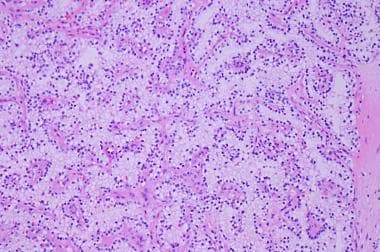

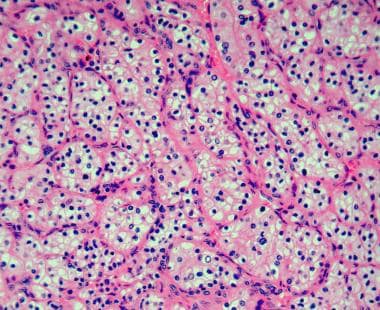
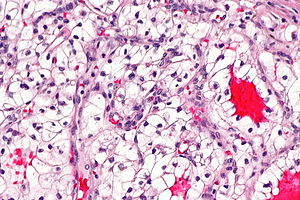
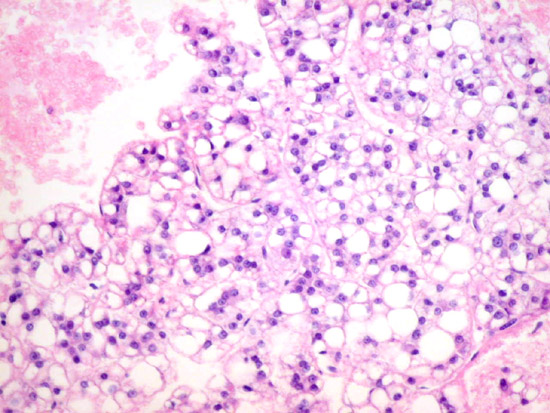
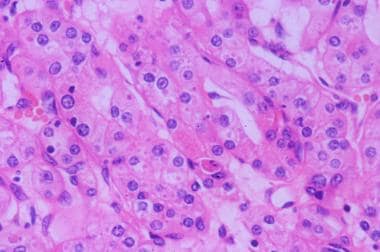
_Nephrectomy.jpg/220px-Renal_clear_cell_ca_(1)_Nephrectomy.jpg)
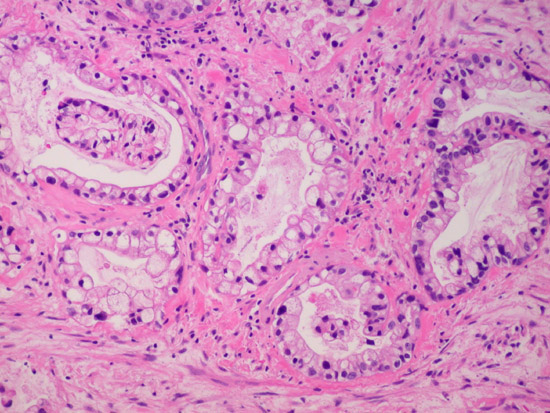
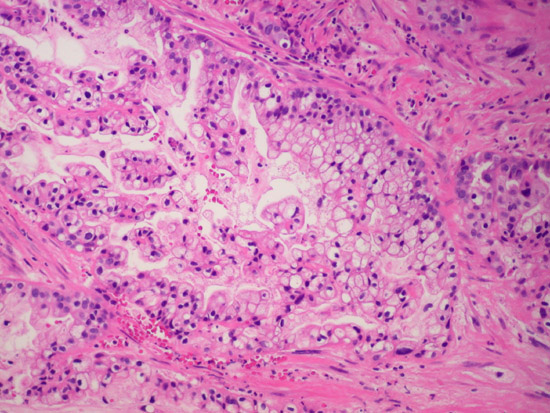
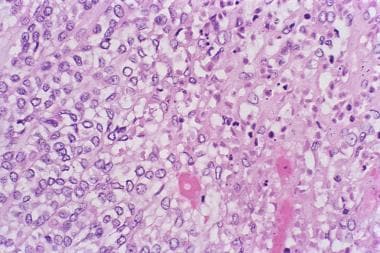

Категория: Инструкции
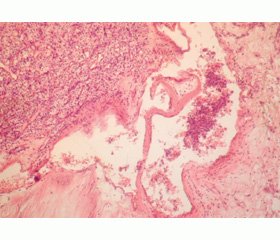
Изучен операционный материал 47 больных после выполненных нефрэктомий с прослеживанием срока жизни и морфологической оценкой опухолей с применением иммуногистохимических методов в двух группах: короткой выживаемости (КВ) (3–6 месяцев) и длительной выживаемости (ДВ) (более 1,5–2 лет). Установлено, что опухоли в этих группах отличались частотой веретеноклеточной эпителиально-мезенхимальной трансформации: в группе КВ она составила 96,4 %, в группе ДВ — 42,1 %; а также ядерной атипии по Фурману: в группе КВ высокая (3–4-й степени) встретилась в 100 % случаев, в группе ДВ — в 68,4 %. Частота веретеноклеточной эпителиально-мезенхимальной трансформации при раке почки может оказаться более чувствительным прогностическим фактором, чем степень ядерного атипизма по Фурману.
Surgical material has been studied in 47 patients after nephrectomy with tracking lifetime and morphological evaluation of tumors using immunohistochemical methods in two groups: of short-term survival (STS) (3–6 months) and long-term survival (LTS) (more than 1.5–2 years). It is found that tumors in these groups differed by incidence of spindle cell epithelial-mesenchymal transformation: in STS group it was 96.4 %, in LTS group — 42.1 %; as well as Furhman’s nuclear atypia: high in STS group (3rd–4th degree) met in 100 % of cases, in LTS group — in 68.4 %. Incidence of spindle cell epithelial-mesenchymal transformation in renal cancer may be more sensitive prognostic factor than the degree of Furhman’s nuclear atypia.
Вивчено операційний матеріал 47 хворих після виконаних нефректомій із дослідженням терміну життя та морфологічною оцінкою пухлин із застосуванням імуногістохімічних методів у двох групах: короткої виживаності (КВ) (3–6 місяців) і тривалої виживаності (ДВ) (більше 1,5–2 років). Встановлено, що пухлини в цих групах відрізнялися частотою веретеноклітинної епітеліально-мезенхімальної трансформації: у групі КВ вона становила 96,4 %, у групі ДВ — 42,1 %; а також ядерної атипії за Фурманом: у групі КВ висока (3–4-го ступеня) зустрілася в 100 % випадків, у групі ДВ — у 68,4 %. Частота веретеноклітинної епітеліально-мезенхімальної трансформації при раку нирки може виявитися більш чутливим прогностичним фактором, ніж ступінь ядерного атипізму за Фурманом.
почечноклеточный рак, эпителиально-мезенхимальная трансформация, степень ядерного атипизма по Фурману.
renal cell carcinoma, epithelial-mesenchymal transformation, the degree of Furhman’s nuclear atypia.
нирковоклітинний рак, епітеліально-мезенхімальна трансформація, ступінь ядерного атипізму за Фурманом.
Для просмотра полной версии статьи, пожалуйста войдите или зарегистрируйтесь.1. Москвина Л.В. Андреева Ю.Ю. Мальков П.Г. Прогностические факторы почечноклеточного рака // Архив патологии. — 2011. — 73(6). — 47-52.
2. Тимофеев И.В. Аксель Е.М. Почечно-клеточный рак в России в 2008 году // The journal malignant tumours (Русскоязычное издание журнала «Злокачественные опухоли»). — 2011. — 1. — 6-10.
3. Bertini R. Roscigno M. Freschi M. et al. Renal Sinus Fat Invasion in pT3a Clear Cell Renal Cell Carcinoma Affects Outcomes of Patients Without Nodal Involvement or Distant Metastases // J. Urol. — 2009 Mar 13 [Epub ahead of print].
4. Chowdhury S. Choueiri T.K. Recent advances in the systemic treatment of metastatic papillary renal cancer // Expert Rev. Anticancer Ther. — 2009. — 9. — 373-9.
5. Conant J.L. Peng Z. Evans M.F. et al. Sarcomatoid Renal cells carcinoma in an example of epithelial-mesenchymal transition // J. Clin. Pathol. — 2011. — 20. — 8-16.
6. Das S. Becker B.N. Hoffmann F.M. Mertz J.E. Complete reversal of epithelial to mesenchymal transition requires inhibition of both ZEB expression and the Rho pathway // BMC Cell Biol. — 2009 Dec 21. — 10. — 94.
7. Ferlay J. Autier P. Boniol M. et al. Estimates of the cancer incidence and mortality in Europe // Ann. Oncol. — 2006. — 18. — 581-92.
8. Golshayan A.R. George S. Heng D.Y. et al. Metastatic sarcomatoid renal cell carcinoma treated with vascular endothelial growth factor-targeted therapy // J. Clin. Oncol. — 2009. — 27. — 235-41.
9. Harten S.K. Shukla D. Barod R. et al. Regulation of renal epithelial tight junctions by von Hippel-Lindau tumor supressor gene involves occludin and claudin and is independent of E-kadherin // Mol. Biol. Cell. — 2009. — 20. — 1083-101.
10. Kallio J. Prognostic factors in renal cell carcinoma. Academic dissertation // Acta Universitatis Tamperensis. — 2004. — Vol. 5. — 43-51.
11. Klatte T. Seligson D.B. LaRochelle J. et al. Molecular signatures of localized clear cell renal cell carcinoma to predict disease-free survival after nephrectomy // Cancer Epidemiol. Biomarkers Prev. — 2009. — 18. — 894-900.
12. Leroy X. Zini L. Buob D. et al. Renal cell carcinoma with rhabdoid features: an aggressive neoplasm with overexpression of p53 // Arch. Pathol. Lab. Med. — 2007. — 131. — 102-6.
13. Lhermitte B. de Leval L. Interpretation of needle biopsies of the kidney for investigation of renal masses // Virchows Arch. — 2012. — 461. — 13-26.
14. Margulis V. McDonald M. Tamboli P. et al. Predictors of oncological outcome after resection of locally recurrent renal cell сarcinoma // J. Urol. — 2009 Mar 13 [Epub ahead of print].
15. Milella M. Felici A. Biology of Metastatic Renal Cell Carcinoma // J. Cancer. — 2011. — 2. — 369-373.
16. Nieto M.A. The snail superfamily of zinc-finger transcription factors // Nat. Rev. Mol. Cell Biol. — 2002 Mar. — 3(3). — 155-66.
17. Nieto M.A. Epithelial-Mesenchymal Transitions in development and disease: old views and new perspectives // Int. J. Dev. Biol. — 2009. — 53. — 1541-7.
18. Radisky D.C. Epithelial-mesenchymal transition // J. Cell Science. — 2005. — 118. — 4325-6.
19. Salamanca J. Nevado M. Martínez-González M.A. et al. Undifferentiated carcinoma of the jejunum with extensive rhabdoid features. Case report and review of the literature // APMIS. — 2008. — 116. — 941-6.
20. Suzuki K. Mizuno R. Mikami S. et al. Prognostic significance of high nuclear grade in patients with pathologic T1a renal cell carcinoma // Jpn. J. Clin. Oncol. — 2012. — 42. — 831-5.
21. Thierry J.P. Acloque H. Huang R.Y. Nieto M.A. Epithelial-mesenchymal transition ns in development and dise–ase // Cell. — 2009. — 139. — 871-90.
22. Tun H.W. Marlow L.A. von Roemeling C.A. et al. Pathway signature and cellular differentiation in clear cell renal cell carcinoma // PLoS One. — 2010. — 8. — 96-106.
23. Weinberg R.A. Mechanisms of malignant progression // Carcinogenesis. — 2009. — 29. — 1092-5.
24. Zhou M. Molecular targets in renal tumors: pathological assessment. Renal cell carcinoma // Humanа Press. — 2009. — 35-48.
Похожие статьиВакцина представляет собой: концентрированную очищенную фиксированную культуру вируса бешенства штамма Wistar, (Rabies PM/Wi 38-1503-3M), культивируемого на человеческих клетках линии ВЕРО; или штамм Внуково-32, выращенный в культуре клеток почек сирийских хомяков, инактивированный ультрафиолетовыми лучами. Обладает способностью стимулировать выработку иммунитета к вирусу бешенства.
Лечебно-профилактическая и профилактическая иммунизация лиц групп риска: лица, профессионально связанные с риском заражения бешенством (сотрудники лабораторий, работающих с уличным вирусом бешенства); лица, профессионально связанные с риском заражения бешенством (в т.ч. сотрудники лабораторий, работающие с экспериментальными животными; ветеринары, охотники, лесники, собаколовы, работники бойни); лечебно-профилактическая иммунизация проводится лицам, подвергшимся нападению или контактировавших с животными с подтвержденным или предполагаемым бешенством (укусы без повреждения кожи, поверхностные царапины, ослюнение поврежденной ткани; единичные или множественные проникающие повреждения кожи, попадание на слизистые оболочки).
Режим дозированияДоза вакцины и схема иммунизации зависят от применяемой лекарственной формы и показаний.
Побочное действиеВозможны незначительная головная боль, головокружение, тошнота, подъем температуры. В редких случаях при возникновении тяжелых аллергических реакций, симптомов поражения системы и повышения температуры более 37°С - показана госпитализация больного. Местные реакции: незначительный отек, краснота, зуд, увеличение региональных лимфоузлов.
ПротивопоказанияПротивопоказаний для лечебно-профилактической иммунизации нет, так как иммунизация проводится по жизненным показаниям. Для профилактической иммунизации имеются следующие противопоказания: острые и инфекционные заболевания; сердечная недостаточность II-III степени; хронические заболевания почек, печени и эндокринной системы; системные заболевания, аллергические заболевания; беременность.
Беременность и лактацияДля профилактической иммунизации беременность является противопоказанием.
Противопоказаний для лечебно-профилактической иммунизации нет, так как эта иммунизация проводится по жизненным показаниям.
Применение при нарушениях функции печениДля профилактической иммунизации хронические заболевания печени являются противопоказанием.
Противопоказаний для лечебно-профилактической иммунизации нет, так как эта иммунизация проводится по жизненным показаниям.
Применение при нарушениях функции почекДля профилактической иммунизации хронические заболевания почек являются противопоказанием.
Противопоказаний для лечебно-профилактической иммунизации нет, так как эта иммунизация проводится по жизненным показаниям.
Особые указанияВ случае укусов животными с нарушением целостности кожных покровов необходимо введение по схеме антирабического гамма-глобулина.
English term or phrase: papillary renal cell carcinoma
Thyroid tumours
Papillary carcinoma constitutes approximately 65 - 80% of thyroid tumours. In all the cases of papillary renal cell carcinoma they did not showed staining with the antibody anti-MAL. The follicular thyroid carcinoma, that constitutes 10 – 15% of thyroid tumours, showed a diffuse staining in the apical region in contrast to the granular staining found in the normal thyroid. In anaplasic carcinoma, which is a rare and aggresive tumour that constitutes less than 5% of thyroid carcinomas, only become stained some cells that presented a different membrane pattern than the typical granular pattern of the normal thyroid follicles.
1 day16 hrs confidence: peer agreement (net): +1
Папиллярный (хромофильный) рак /cемейный папиллярный рак
Explanation:
То, что есть в англоязычных источниках, больше подходит под определение (перевод) хромофильноклеточная карцинома почки
Ноя не могу проявлять такую самодеятельность, так как в статье из ведущего Центра онкологии РФ приведена классификация, почти дословно повторяющая ту, что ниже процитирована мною на английском языке- но название приводится в таком виде, как я вписала в графу- термин.
Меня смутило сразу то, что эта опухоль явно носит наследственный(семейный, генетический) характер, судя по исследованиям экпрессии протеина, пр. Следовательно, это не должно быть широко известное и распространенное заболевание, коим является приведенное в ответе коллеги.
http://www.chtfoms.ru/index.php?option=doctor&task=viewartic.
В основе традиционных классификаций рака почки лежат особенности морфологии клетки и клеточного ядра. Учитывая данные морфологических, цитогенетических и молекулярных исследований, выделяют 5 видов рака почки: светлоклеточный - 60-85%, хромофильный (папиллярный) - 7-14%, хромофобный - 4-10%, онкоцитарный - 2-5%, рак собирательных протоков - 1-2%
http://www.cancercenter.ru/www.ronc.ru/_123/614911.html
(Лаборатория патологической анатомии опухолей РОНЦ им.Н.Н.Блохина) ВОПРОСЫ КЛАССИФИКАЦИИ И ДИАГНОСТИКИ
ЭПИТЕЛИАЛЬНЫХ ОПУХОЛЕЙ ПОЧЕЧНОЙ ПАРЕНХИМЫ
Достижения иммуногистохимии, электронной микроскопии, генетики позволили существенно уточнить представления об эпителиальных опухолях почек, и следовательно, усовершенствовать их классификацию. Целью доклада является ознакомление отечественных морфологов с Международной классификацией опухолей почек (1998), а также обсуждение спорных положений, которые определились за время работы с этим документомРис. 1-3: Злокачественные эпителиальные опухоли почечной паренхимы. (Пояснения в тексте).
ПАПИЛЛЯРНЫЙ (хромофильный) рак (РИС.2). Опухоль обычно возникает в одном из полюсов почки, имеет характерный «сальный» центр, может распространяться на лоханку, мозговое вещество. Опухоль может быть ограничена тонкой капсулой; она состоит из эозинофильных, базофильных и светлых клеток, образует, наряду с сосочками, тубулярные, солидные и трабекулярные структуры. В сосочках частой деталью являются ксантомные клетки, сидерофаги, характерны очаги кровоизлияний, некроза, кисты. Отдельные опухоли могут выглядеть как сосочковые цистаденокарциномы. Микроскопический диагноз устанавливается в тех случаях, когда число истинных сосочков достигает 50-75% всей опухоли. Большая часть опухолей имеет II степень злокачественности и относительно благоприятный прогноз.
Далее- описание другого вида почечно-клеточного рака:
Почечно-клеточный рак, ассоциированный с кистой. Классификация ВОЗ различает два типа таких опухолей: рак, возникший в кисте и рак с преобладанием кистозных полостей. Элементы опухоли (характерные светлые клетки, папиллярные, солидные и др. структуры) определяются в стенке кистозных полостей. Новообразования возможно расценить как разновидности светлоклеточного рака. Прогноз сравнительно благоприятный
Вот аналогичное описание на английском языке(классификация и название опухоли)http://www.infobiogen.fr/services/chromcancer/Tumors/kidney5.
Papillary renal cell carcinoma
Other names -chromophilic renal cell carcinoma
renal cell carcinoma form a heterogeneous group of tumours which can be divided into several subgroups according to their cytology, architecture, and the part of the nephron from which tumour cells are derived: five basic cell types are recognized: clear-cell, CHROMOPHILIC-CELL (also called PAPILLARY RENAL CELL CARCINOMAS (PRCC), herein described), chromophobic-cell, oncocytic-cell, and collector duct cell types a certain correlation exists between cell type and architecture of the tumour: the clear-cell type tends to show compact growth, while the chromophilic-cell type is more readily associated with tubulo-papillary architecture Etiology -a hereditary form, called Hereditary papillary renal cell carcinoma, of autosomal dominant transmission, has been recently recognized; it predisposes to develop multiple, bilateral renal tumours
Epidemiology- papillary renal cell carcinomas (PRCC) represent about 10% of all renal cell tumours; there is a clear excess of male patients (male to female ratio: 5 to 1)
Pathology- papillary renal tumours are composed of at least 50% of papillary structures, formed by connective tissue stalks covered by small or medium size cuboid cells with eosinophilic or basophilic granular cytoplasm ; renal cortical adenomas are frequently associated with PRCC in the same kidney, suggesting the possibility of transformation from adenoma to carcinoma
http://thyronet.rusmedserv.com/doct/thyr-2-01-1.htm
Семейный папиллярный рак
Наконец ген семейной форме ПРЩЖ в сочетании с раком почки был локализован на 1q21 хромосоме48.
Papillary thyroid carcinoma associated with papillary renal neoplasia :genetic linkage analysis of a distinct heritable tumor syndrome. J Clin Endocrinol Metab 2000, 85: 1758-1764.
http://genetics.rusmedserv.com/add/article_22.html
Malchoff CD, Sarfarazi M, Tendler B, Forouhar F, Whalen G, Joshi V, Arnold A, Malchoff DM. Papillary thyroid carcinoma associated with papillary renal neoplasia: genetic linkage analysis of a distinct heritable tumor syndrome. A distinct inherited tumor syndrome has been characterized as the familial association of papillary thyroid cancer, nodular thyroid disease, and papillary renal neoplasia. The predisposing gene in a large kindred with this syndrome has been mapped to 1q21. J Clin Endocrinol Metab 2000 May;85(5):1758-64
http://www.cancer.org/docroot/cri/content/cri_2_4_1x_what_is.
There are 5 main types of renal cell carcinoma that are identified by examining the tumor under a microscope: clear cell, papillary, chromophobe, collecting duct, and "unclassified."
When viewed under a microscope, clear cell renal cell carcinoma appears very pale or clear. This is the most common form of renal cell carcinoma. About 70% to 80% of people with renal cell carcinoma have this kind of cancer.
Papillary renal cell carcinoma is the second most common type—about 10% to 15% of people have this kind. These cancers form little finger-like projections papillae in some if not most of the
tumor. Some doctors call these cancers chromophilic because the cells take up certain dyes used in preparing the tissue to be viewed under the microscope, causing them to appear pink.
http://www.medterms.com/script/main/art.asp?articlekey=31333
Papillary renal cell carcinoma: A type of kidney cancer that accounts for 15 to 20% of renal carcinomas. It occurs in both sporadic and familial forms. Hereditary papillary renal carcinoma is characterized by the development of multiple papillary tumors in both kidneys. The pattern of inheritance is consistent with autosomal dominant transmission with reduced penetrance. The disorder is distinct from other forms of inherited kidney cancer
In adults, most kidney cancers develop in the tissues that filter blood and produce urine. This type of cancer is called renal cell cancer. Cancer of the renal pelvis is called transitional cell carcinoma. This disease is very much like the type of cancer that occurs in the bladder, and it is often treated like bladder cancer
http://web.ncifcrf.gov/research/kidney/pap.html
Renal cell carcinoma (RCC) is the most common malignant neoplasm of the kidney which constitutes 2-3% of all malignant tumors in adults. Previous attempts to classify renal carcinomas histologically fell into disrepute in Western Europe and the United States because there was no correlation between the histological appearance of renal
carcinomas and prognosis. Recently, Thoenes and his group proposed a new histological classification of renal epithelial tumors based on the cell of origin in the kidney neophron and the histological appearance of tumor cells. There is a good correlation between Thoenes classification of renal cell carcinoma and genetic changes. The current classification of renal cell carcinomas includes: 1) clear cell (origin from proximal tubule; 70-75% of renal tumors); 2) chromophil cell (proximal tubule; 15% of tumors; includes papillary renal cell carcinoma of Kovacs); 3) chromophobe cell (distal-connecting tubule; 4%); 4) oncocytic (connecting tubule; 2-3% of tumors; includes oncocytoma); 5) collecting duct carcinoma and medullary carcinoma (cortical medullary collecting duct; 1% of tumors); 6) pleomorphic/spindle/sarcomatoid (dedifferentiated, pure or associated with other renal cell carcinoma types; 1%).
PAPILLARY RENAL CELL CARCINOMA (chromophil cell carcinoma)
This type of renal cancer was described in 1989 by Dr. Kovacs. Unlike most other RCC, these lesions are hypovascular or vascular on renal arteriography. The tumors of this type have different biologic and cytogenetic characteristics as compared with nonpapillary RCC. The tumor is classified as a true papillary RCC if at least 75% of the neoplasm shows papillary growth pattern, with remaining tumor having a tubulopapillary architecture composed of granular cells. Papillary RCC often undergo extensive necrosis and cyst formation and exhibit prominent stromal infiltration by foamy macrophages. Papillary RCC may occur sporadically or present in family members as multifocal tumor nodules in bilateral kidneys. Histological examination of adjacent renal parenchyma may show microscopic neoplasms.
Clear cell renal carcinomas comprise about 80% of sporadic renal cell carcinomas while papillary renal carcinomas comprise about 5-10% of sporadic renal cell carcinoma.
Karyotypes prepared from papillary renal carcinomas show characteristic genetic changes distinct from those found in karyotypes prepared from clear cell renal carcinomas. Papillary renal carcinomas show trisomy of chromosomes 7, 16 and 17, and in male patients, a loss of the Y chromosome

Медицина: главная клетка околощитовидной железы, клетка-родоначальник меланоцитов кожи, паренхиматозная клетка новообразований (напр. почки). клетка-родоначальник (меланоцитов кожи). главная клетка (околощитовидной железы). прозрачная клетка (клетка с высоким уровнем гликогена, который не окрашивается красителями, из-за чего под микроскопом цитоплазма клетки кажется пустой)
Универсальный англо-русский словарь. Академик.ру. 2011 .
Смотреть что такое "clear cell" в других словарях:clear cell — A type of cell that looks clear inside when viewed under a microscope … English dictionary of cancer terms
Clear-cell sarcoma — Classification and external resources Clear cell sarcoma. Tumor cells with prominent nucleoli and clear cytoplasm are arranged in well defined nests surrounded by dense fibrous stroma. ICD O … Wikipedia
Clear cell adenocarcinoma of the vagina — Classification and external resources ICD O: 8310/3 DiseasesDB 2786 MeSH … Wikipedia
Clear cell adenocarcinoma — Classification and external resources Micrograph of an ovarian clear cell adenocarinoma. H E stain … Wikipedia
Clear-cell sarcoma of the kidney — Classification and external resources ICD O: 8964/3 Clear cell sarcoma of the kidney is a rare type of kidney cancer. Clear cell sarcoma can spread from the kidney to other organs, most commonly the bone, but also including the lungs, brain, and… … Wikipedia
Clear cell papillary renal cell carcinoma — Classification and external resources Micrograph of a clear cell papillary renal cell carcinoma showing the characteristic apically located nuclei. H … Wikipedia
Clear-cell tumor — can refer to: clear cell sarcoma (including clear cell sarcoma of the kidney) clear cell adenocarcinoma This disambiguation page lists articles associated with the same title. If an … Wikipedia
Clear-cell squamous-cell carcinoma — (also known as Clear cell carcinoma of the skin ) is a cutaneous condition, a subtype of squamous cell carcinoma, characterized by keratinocytes that appear clear as a result of hydropic swelling.[1]:743 References ^ Freedberg, et. al. (2003).… … Wikipedia
Clear cell acanthoma — (also known as Acanthome cellules claires of Degos and Civatte, Degos acanthoma, and Pale cell acanthoma ) is a benign clinical and histological lesion initially described as neoplastic, which some authors now regard as a reactive dermatosis. It… … Wikipedia
clear-cell carcinoma — clear cell adenocarcinoma a variant of adenocarcinoma that tends to arise from the kidneys or the female genital tract. In the latter case it is linked to intrauterine exposure to diethylstilbestrol during the 1950s and 1960s and takes the form… … The new mediacal dictionary